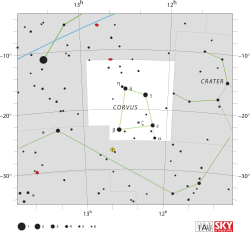Beta Corvi
| Observation data Epoch J2000.0 Equinox J2000.0 (ICRS) |
|
|---|---|
| Constellation | Corvus |
| Right ascension | 12h 34m 23.23484s |
| Declination | −23° 23′ 48.3374″ |
| Apparent magnitude (V) | 2.647 |
| Characteristics | |
| Spectral type | G5 II |
| U−B color index | +0.586 |
| B−V color index | +0.898 |
| R−I color index | +0.44 |
| Astrometry | |
| Radial velocity (Rv) | −7.6 km/s |
| Proper motion (μ) |
RA: +1.11 mas/yr Dec.: −56.56 mas/yr |
| Parallax (π) | 22.39 ± 0.18mas |
| Distance | 146 ± 1 ly (44.7 ± 0.4 pc) |
| Absolute magnitude (MV) | –0.61 |
| Details | |
| Mass | 3.7 ± 0.1 M☉ |
| Radius | 16 R☉ |
| Luminosity | 164 L☉ |
| Surface gravity (log g) | 2.52 ± 0.03 cgs |
| Temperature | 5,100 ± 80 K |
| Metallicity [Fe/H] | –0.01 dex |
| Rotational velocity (v sin i) | 8 km/s |
| Age | 2.06 × 108 years |
| Other designations | |
| Database references | |
| SIMBAD | data |
Beta Corvi (Beta Crv, β Corvi, β Crv) is the second brightest star in the southern constellation of Corvus. It has the traditional name Kraz. The origin and meaning of this name remains uncertain.
The Proper Name Kraz for Beta Corvi appeared in a 1951 publication, Atlas Coeli (Skalnate Pleso Atlas of the Heavens) by Czech astronomer Antonín Bečvář. Professor Paul Kunitzch has been unable to find any clues as to the origin of the name.
In Chinese, 軫宿 (Zhěn Sù), meaning Chariot (asterism), refers to an asterism consisting of β Corvi, γ Corvi, ε Corvi and δ Corvi. Consequently, β Corvi itself is known as 軫宿四 (Zhěn Sù sì, English: the Fourth Star of Chariot.).
Beta Corvi has about 3.7 times the Sun's mass and is roughly 206 million years old, which is old enough for a star of this mass to consume the hydrogen at its core and evolve away from the main sequence. The stellar classification is G5 II, with the luminosity class of 'II' indicating this is a bright giant. The effective temperature of the star's outer envelope is about 5,100 K, which produces a yellow hue common to G-type stars.
The measured angular diameter of this star is 3.30 ± 0.17 mas. At an estimated distance of 146 light-years (45 parsecs), this yields a physical size of about 16 times the radius of the Sun. Because of the star's mass and radius, it is emitting about 164 times the luminosity of the Sun. The abundance of elements other than hydrogen or helium, what astronomers term metallicity, is similar to the proportions in the Sun.
...
Wikipedia

